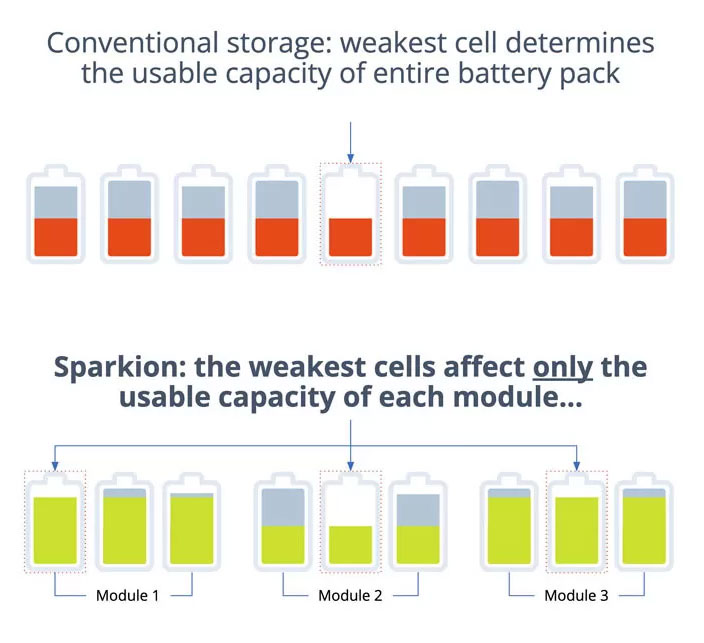Maximize Investments and Minimize Environmental Impacts
with Second-Life EV Batteries
Battery energy storage systems (BESS) paired with onsite renewables and EV charging stations can decrease energy costs, increase revenue and establish energy resilience.
EV battery reuse in commercial energy storage systems can add further value to charge point operators (CPOs), while auto manufacturers and fleets have a unique opportunity to repurpose their own batteries in depot battery storage for EV charging to add economic and environmental benefits.
Sparkion’s revolutionary technology helps CPOs, automakers and fleet operators get the most out of second-life EV batteries by generating more energy per cycle to reduce BESS cost-per-kWh by as much as 60% while cutting CapEx cost to half of competitive solutions.
Second-life EV battery benefits
Used EV batteries still maintain 70-80% of their capacity.
- Meet increasing demand with cost-effective, reliable power
Increased power demand and high utility charges can undermine the value of transitioning to EVs. Charging depots and enterprises from EVs to C&I to utilities and more are investing in energy storage to reduce operating costs and maintain vehicle uptime with cost-efficient, resilient energy. - Increase ROI
Used electric vehicle batteries still maintain 70-80% of their capacity—enough to power your onsite commercial battery storage systems. Repurposing EV batteries in your BESS can provide even more value through reduced costs, more efficient EV charging. Fleet owners are in a unique position to reduce energy and BESS costs by repurposing their own battery inventory. - Mitigate environmental impact
Rather than using more new batteries, Sparkion’s solution repurposes retired EV batteries into a BESS. This battery recycling reduces waste and prevents additional Earth mineral depletion, enhancing your sustainability efforts and economics. Pairing your BESS with onsite clean energy can even further your impact.
Optimizing second-life EV batteries with Sparkion
Generate more energy per cycle to reduce BESS cost-per-kWh by as much as 60% while cutting CapEx costs
In a conventional EV battery storage unit, the weakest cell drags down the usable capacity of the entire battery pack, decreasing economic efficiency. Sparkion’s proprietary SparkSwitch technology allows bypassing weak cells to generate more energy per cycle to reduce the BESS cost-per-kWh by as much as 60% while cutting CapEx cost to half of competitive solutions.

Flexible, AI-driven storage management
Sparkion’s AI-driven solution enables turning retired second-life EV batteries into viable energy storage for EV charging regardless of manufacturer, chemistry or state of health. Our SparkCore energy management system uses proprietary algorithms to meet site goals with proactive, real-time monitoring to control the BESS and optimize stored energy deployment across your EV charging stations.
Optimized automated control of all site assets
Benefits of the Sparkion solution include:
- Turning your retired EV batteries into viable energy storage systems
- Significantly extending the life and throughput of second-life batteries
- Reusing batteries of different chemistries, manufacturers and states of health
- Enhancing output with a configurable, modular storage platform
- Cloud interface with flexible API for third-party connections
- Intelligent storing and charging across all site assets
- Peace of mind with automated control in line with business goals
- Enabling sustainable power for a sustainable future
- Increased value to customers
- Reducing utility charges
- Maximizing vehicle up-time
- Establishing energy resilience
FAQs
What are second-life batteries?
Second-life batteries are previously used electric vehicle batteries that are reused in EV charging stations. Used EV batteries still maintain 70-80% of their capacity after they’re retired, so while they are no longer able to power a car, their capacity is enough to help charge vehicles.
Why are second-life batteries a good option for fleets?
Fleets have a unique opportunity to use their own repurposed batteries in depot storage systems to reduce energy and BESS costs and increase economic and environmental benefits.
Why should I choose Sparkion to utilize second-life batteries?
Sparkion’s proprietary SparkSwitch technology allows bypassing weak cells to generate more energy per cycle. This allows CPOs, automakers and fleet operators to get the most out of second-life EV batteries by reducing BESS cost-per-kWh by as much as 60% while cutting CapEx cost to half of competitive solutions.
Additional Resources:
7 advantages of real-time monitoring
Fleet Operators
Discover battery storage applications for fleet operators.
Fueling Stations
Explore Power Assist’s impact in the fueling station industry.

